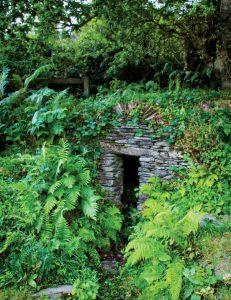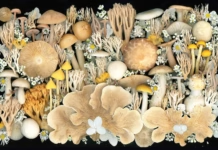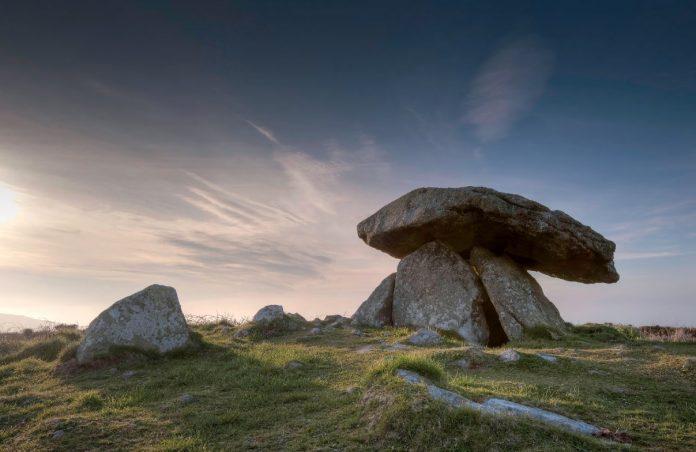PHOTOGRAPHY BY SIMON CHAPMAN AND THE AUTHOR
After researching Scottish fairy sites from the lowlands of Edinburgh and Stirling to the Highlands of Bute and Argyll, Faerie Magazine editor at large, Laren Stover, and editorial director, Paul Himmelein, were drawn to explore the wild coasts and romantic moors of the Cornwall peninsula looking for tales of fairy-human interaction. From subterranean mining sprites known as Knockers to singing mermaids to the myriad piskies (Cornish pixies) that guard the legendary sites of Penwith, the two were charmed to discover that Cornwall literally is a fairyland.
LED ASTRAY
I didn’t know much about this corner of Britain that jutted into the north-flowing jet stream aside from the surprising fact that tropical-looking palm trees speckled the landscape. Everything else I knew about Cornwall came from literary references such as the Pirates of Penzance, those sherry-swilling, kindhearted brigands in Gilbert and Sullivan’s comic opera (first performed 1879) and the band of cutthroat wreckers that lured ships onto the rocks so they could carry off its valuables in Daphne du Maurier’s mystery Jamaica Inn (1936), and Winston Graham’s twelve-volume, 18th century Cornish saga about a man called Poldark.
It was obvious there was something enchanted about this journey from the outset. A free upgrade from coach to business class with our own reclining beds made the transatlantic flight a breeze. We landed on a rare sunny morning at London’s Heathrow Airport. I gathered up my unwieldy road maps, bracing for the nearly four-hour drive from the airport to our lodging in eastern Cornwall, but a free upgrade to a luxury Mercedes with a satellite navigation system rendered my highlighted maps moot.
There’s really nothing quite like a weekend road trip with blue skies, plenty of coffee, and no traffic. I felt we were making good time and obeyed the pleasant female voice that guided me from the madness of urban intersections and harrowing roundabouts to the smooth motorway that unfurled before me through the countryside. I followed the orders of the disembodied voice onto an exit ramp. I hadn’t realized I had made such quick time, yet there was something that didn’t feel right. Sure, I had pored over my maps trying my best to commit them to memory. My plan was to take the M4 to the M5, the fastest route to Cornwall, but how could I argue with the GPS? It didn’t take long to realize I had been directed off the motorway and was being shepherded into the center of Salisbury. I instantly regretted falling prey to technology and forsaking my trusty printed maps. Why would this artificially intelligent lady tell me to take this route when it would clearly delay my travels? Apparently, there was a ghost in the machine … or should I say pixie? Soon the fairies’ machinations revealed themselves when we saw signs pointing the way to Stonehenge.
I had visited the prehistoric standing stones over a decade earlier, but Laren—whose deceased father, Dr. Leon Stover, was an anthropologist and H.G. Wells scholar who wrote extensively about Stonehenge—had never seen them in person. There was definitely a force leading us to this iconic Bronze Age site. When the unseen world takes over, it’s best not to resist. Laren was able to finally visit the legendary stones that her father had spent so much time exploring and writing about. It turned out this was the perfect route to take to Cornwall.
Just before twilight, we arrived at the remote, late 18th century folly known as Whiteford Temple. This was to be our first camp as we explored the pixie possibilities of Cornwall. Built in 1799 for Sir John Call, who earned his fortune working for the East India Company, the temple is designed around a large center room with three glazed arches looking over the green patchwork valley of the Tamar River.
OF SPRITES AND SAINTS
The next morning we started in pursuit of piskies. We had heard of a sacred well known as St. Nun’s Well, also called the Piskies’ Well, that was guarded by a benevolent elf not so far away from our folly. There are many wells and springs in Cornwall that are supposed to be enchanted in some manner or another, whether they have healing properties, divination acumen, or merely gain the favor of a fairy or the promise of a pisky. The waters of sacred wells have been used as eyewashes to restore sight, drive away madness, or find out how loved ones living at a distance were faring before the age of the telephone:
“Water, water, tell me truly,
Is the man that I love duly
On the earth, or under the sod,
Sick or well? In the name of God.”
Depending upon how the water bubbled up, the person in question was either in good heath, ill, or dead. As Christianity took hold of Britain, the Church saw the futility of shutting down these superstitions and beliefs and so adopted them by using these pisky and fairy wells for sacramental rites and swapping the sprite for a saint whose miraculous powers could absorb the piskies’ magic.
Finding St. Nun’s Well was a challenge and caused us to inquire after its whereabouts at the Jubilee Inn in Pelyant. Thankfully, the well wasn’t so far away. A barmaid remembered walking there a few times when she was younger to make wishes for long thick hair and told us the way: “Make a left and then take the second left and go straight down … you’ll see signs.” These simple directions took several attempts and even brought us to an old abandoned lime kiln in the shade of a dense forest alongside a road that was scarcely wide enough for our sleek Mercedes, yet it was a sobering moment to discover this was indeed a two-way road as a large SUV came at us head on. Another inquiry at a guesthouse at the end of a dead end yielded better directions and eventually took us to a gate marked “Hobb’s Park.” We walked down the private drive still wondering if we were heading in the right direction until we finally saw a small wooden sign painted with the words “St. Nun’s Well” and a pointing hand directing us onward.
A steep path beneath the shade of an oak tree led us to a bramble- and bracken-covered stone structure. Inside the stone house the walls were dripping wet and covered in vibrant green liverwort, dangling spleenwort, and hart’s tongue—fairy flora, indeed. A spring at the back oozes water like teardrops into a granite basin. It’s still believed the elf that guards the well inside this grotto-like dwelling dispenses wishes to those that leave an offering such as a coin or bent pin, but beware to those that damage or vandalize the well or its surroundings. Then the pisky will send nothing but ill their way.
There’s a famous story about a well-to-do farmer in the region who, after seeing the granite basin in the grotto, got it in his mind to drag the basin off and use it as a trough in his pigsty. He drove his two strongest oxen to the well and chained the sacred basin to his beasts to wrench it free from its ancient site. The oxen toiled diligently to drag the heavy granite up the hillside but the chains could not hold the enchanted basin and it broke free and rolled back down the slope, turning as if guided by an invisible hand only to come to rest in its original position where it has since remained unmoved. The unfortunate farmer became instantly lame and dumb and never prospered again.

We next traveled across Bodmin Moor on our way to Dozmary Pool to visit the famous Arthurian location where Sir Bedivere tossed the king’s sword, Excalibur, into the lake and we stopped near the church of St. Neot for lunch. Once our interest in fairies was made known, the paunchy, barefoot landlord of the pub opened up and told us of an ancient fairy well with magical properties within walking distance. Like St. Nun’s Well, this fairy well was hidden inside a stone house too. It was renovated in the mid-19th century when the roots of oaks and willow trees had caused the ancient structure to crumble. Behind a latched wooden door was another damp and dripping interior, though this one was not lush with greenery. The well looked shallow and was carpeted with copper coinage, attesting to heavy wishing. There is a legend that marries the well with the fairies’ dislike of hunting. Once when St. Neot was at the well praying, a deer ran up to him to seek protection. When the snarling hounds arrived, they immediately quieted and lay down at the feet of the saint. Shorty after, the hunter stepped from the forest with bow drawn and saw this unexpected scene of tranquility and animal harmony. He became so moved that he renounced hunting evermore.
Though there were many more enchanted wells to explore, we made it to only two more during our explorations: Madron Well—called so after St. Madern—and the fairy well at Carbis Bay. Dr. William Borlase (1669–1772), author of The Natural History of Cornwall , commented on Madron Well: “Here, people who labour under pains, aches and stiffness of limbs come and wash, and many cures are said to have been performed … Hither also come, the uneasy, the impatient, and the superstitious, and by dropping pins or pebbles into the water, and by shaking the ground round the spring, so as to raise bubbles from the bottom, at certain times of the year, moon and day, endeavor to settle such doubts and enquires as will not let the idle and anxious rest.”
Two and a half centuries later, pilgrims to Madron Well still leave votive offerings or clouties, strips of fabric dipped into the water of the enchanted holy well. They are then tied to branches of a nearby tree while a prayer is said to the spirit of the well. We arrived at Madron Well after the sun drove the morning rain away. Shafts of golden light illuminated trinkets—tied ribbons, knotted rags, tarot cards, beaded necklaces, gemstone pendants, and even a Barbie’s head—all dangling from the canopy of leafy branches and twigs. It looked either like a Mardis Gras piñata had exploded or a contemporary art exhibition had been installed in the middle of the woods.
The final well we visited was the Carbis Bay fairy well. Down a steep lush green hillside, just above the turquoise waters of Carbis Bay, the well is set in the most enchanting surroundings. Here visitors are expected to leave something silver behind if they wish the favor of the fairies. Some say if you throw a crooked pin over your back and it lands in the well, your wish will come true. If not … well, keep trying.

































Thanks for your marvelous posting! I definitely enjoyed reading it, you are a great author.I will
ensure that I bookmark your blog and will eventually come back sometime soon. I want
to encourage you to definitely continue your great job, have a nice morning!
Merely a smiling visitor here to share the love (:, btw outstanding style and design.